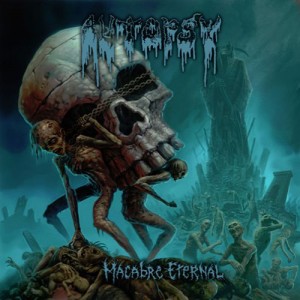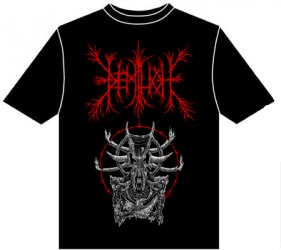
The last couple of years have seen a artistic renaissance of a genre that throughout the best part of the mid- to late 90′s, and the early reaches of the millennium, was perceived to be a ghost that had long outlived it’s most glorious moments of artistic clarity. Great quantities of ‘gore’ and ‘brutal’ Death Metal acts have over the last two decades, dumbed down the mystical perversity that gave a genre the likes of Blessed Are The Sick, Legion, Cause Of Death, Onward To Golgotha, Imperial Doom, has in years past given way to acts that aim principally for shock value, sidetracking any of the compositional and dynamic attributes that were the essence of what made Death Metal so vital in it’s 1989-1993 heyday.
It’s great that Autopsy should record such a gem as this, as it serves to vanquish the plasticity and dross that once great acts such as Morbid Angel and Deicide have spluttered forth. Not only does it filter out these negatives, but it also does great justice to many artists who embrace an archaic yet craftsmanlike and refreshing interpretation of Death Metal.
In addition to having put out the excellent ‘The Tomb Within‘ EP last year, Autopsy have eschewed the notion of ‘re-recordings’ or filtering previously released material onto this new record. Instead what we have is a colossal, quite lengthy record, lasting greater than an hour but never straying from momentum and vibrancy.
It wouldn’t be unfair to say that in terms of intricate song structuring, Autopsy have perhaps even upped on what they originally achieved on Severed Survival and Mental Funeral, with a more obvious sense of grandeur. This exhibits itself on tracks such as ‘Bridge Of Bones’ and ‘Sadistic Gratification’, which sound somewhat like a logical conclusion of what was being hinted at on their second album. Eric Cutler’s riffs and modes are the usual tritonal, Black Sabbath meets Hellhammer-esque death dirges, which occasionally recycle patterns and forms familiar in early material, yet also giving the album a renewed sense of consistency. It is this grasp of orthodoxy within the metal genre which always makes for contributing to the collective framework of the artists work, which Autopsy fulfill here.
This is however not to say that there are flourishes of ‘experimentation’. Luckily the band have played a good hand of cards, and have not fallen into the ludicrous corner of ‘evolving for the sake of it’. Particular songs on ‘Macabre Eternal’ show the band using greater song lengths than before (‘Sadistic Gratification’, ‘Sewn Into One’), and also display a greater sense of direct melodicism (‘Dirty Gore Whore’). Whilst Autopsy have never been associated with playing at fast speeds, large stretches of this album are more uptempo.
 Chris Reifert is on top form as a vocalist. His ability to evoke majestic visions of dismemberment and perversion seem to contain a greater dynamic than usual, as to suggest that nearly fifteen years of prolonged absence has only allowed his strengths to re-accumulate.
Chris Reifert is on top form as a vocalist. His ability to evoke majestic visions of dismemberment and perversion seem to contain a greater dynamic than usual, as to suggest that nearly fifteen years of prolonged absence has only allowed his strengths to re-accumulate.
Though certainly not a complaint on behalf of the reviewer, what may potentially put off some fans of earlier material is the production, which is undeniably modern in tone. Whilst Chris Reifert’s drumming is still top notch the only minor complaint being that the compression on his drumkit seems to somewhat nullify the sense of ability, flair and aggression that a more analogous production would bring out. Whilst Macabre Eternal possesses all of the right atmosphere and conviction worthy of great death metal, the more aesthetically orientated listener will notice that the overall tonality is not as analogous as what was committed to tape in the 80′s and 90′s.
In spite of this minor specific, this album is superb, and rightly deserves to be considered a beacon of the revivification of a dark and morbid art form that until the turn of the new millennium, was considered a dead horse. Hail the new dawn. Not only in terms of structural and grandiose perversion does this album triumph, but fragments of it’s lyrical scope only serve further as to compliment the metaphysical and transcendental nihilism that death metal eternally symbolizes.
“Under the sign of a skull faced moon
We rise from abysmal embryotic doom
Existence as torment, yet locked in a grave
A sick fragile cycle from which no one is saved”
Within the recent decade, this is the best ‘comeback’ release that has emerged from any of the elder practitioners of the genre. Undoubtedly, this shall also be a worthy contender for being the best album of the year.
-Pearson-
No CommentsTags: American Death Metal, death metal, Gore, Horror, Nihilism, Old School Death Metal

 Chris Reifert is on top form as a vocalist. His ability to evoke majestic visions of dismemberment and perversion seem to contain a greater dynamic than usual, as to suggest that nearly fifteen years of prolonged absence has only allowed his strengths to re-accumulate.
Chris Reifert is on top form as a vocalist. His ability to evoke majestic visions of dismemberment and perversion seem to contain a greater dynamic than usual, as to suggest that nearly fifteen years of prolonged absence has only allowed his strengths to re-accumulate. The new batches of Demilich shirts will be printed soon, but before that, some of the sizes that were sold out are now back in sale in very limited quantities.
The new batches of Demilich shirts will be printed soon, but before that, some of the sizes that were sold out are now back in sale in very limited quantities.
